The Soviet missile Mine-clearing solution
The UR-77 Meteorit was developed in the 1970s as a variant of the ubiquitous 2S1 Gvodzika self-propelled howitzer and replacement for the old UR-67. The acronym of "Ustanovka Razminirovaniya" ("mine clearance system") is added to the year of acceptance (1977) as customary for Soviet types. It is still currently used a specialized mine-clearing vehicle, but also in other offensive roles (mainly in urban areas) as shown in the recent war in Ukraine. Production figures are ellusive, about several dozens at best, with some purchased by Azerbaijan, Syria and in Moldova by the Transnistrian pro-Russian separatists.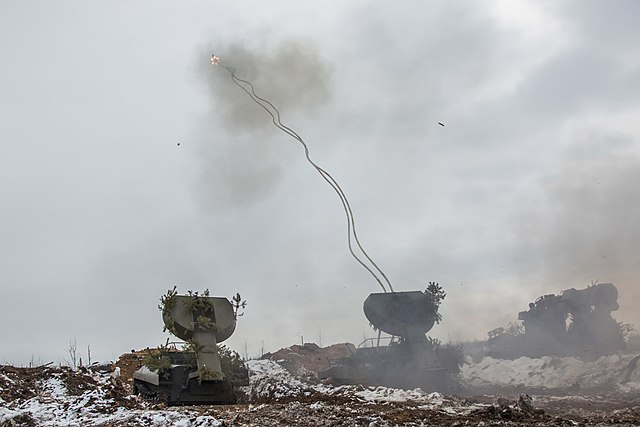
The UR-77 is today the only MICLIC in service in the Russian inventory, as it was in the former Soviet one. There is no planned replacement known yet. This very special vehicle is assigned to specialized mine-warfare units, in independent companies that can be attached organically to any larger unit, on demand on the front.
A short history of the MICLIC
Mine-clearing vehicles has been in use since WW1, and a bit left over until WW2 sprung out a new life into this specialized branch of motorized infantry. It is indeed traditionally attached to the infantry as a way to clear a path before it, helping to reach its objectives despite minefields in its path. The common WW2 solution was a mine-roller (still in use today), but the path cleared was somewhat narrow and could be long to clear out, while the detonations could affect directly the carrier vehicle.Thus is appeared important to develop a "remote" mine-clearing solution, and it was developed already in 1942 by the allies: For example, the British and Commonwealth were pioneered in this, like the Canadians and their "Snake", an oversized Bangalore torpedo application, still rigid, and more flexible variant called the "Conger" in 1944. It was a 2-inch (51 mm) woven hose to be fired across the minefield, filled with explosive before detonation. it's carrier was a standard allied 5-inch (127 mm) rocket. The tube and rocket were usually carried and depliyed by a fairly common tankette, the Universal Carrier, stripped out so much it could be towed by a Churchill AVRE. The rocket was fired and "towed", deploying the full lenght of the hose across the mined area. It was empty to avoid explosng on impact, but when static, compressed air was pump into it followed by the liquid explosive, a ton of "822C" nitroglycerin before detonation. Conger was used in Normany until the 20th October 1944 drama at IJzendijke, Netherlands when four AVREs were resupplied in a depot for Operation Switchback (Battle of the Scheldt). Jerry Cans of Nitro-Glycerine were being unloaded by two Bedford supply trucks when it detonated, the resulting explosion vaporising the two trucks, destroyed the two AVREs while making 47 deads and 37 wounded. It was never used again, mostly due to the nitro-glycerine.
Based on this experience in 1950, the British worked on a much improved version called the "Giant Viper". The latter was trailer-mounted and vehicle-pulled behind a Centurion in its AVRE variant FV4003, and later the FV432 Armoured personnel carrier. The Giant Viper was a 250 m long (820 feet) hose launched by rocker and already packed with low-sensitivity, save plastic explosive across a minefield. It got rid of the highly dangerous nitro, and was already filled, gaining time in deployment. The system cleared a 20 feet wide path, clearing both anti-personnel and anti-tank mines, using the principle of "sympathetic detonation", on around 200 metres (656 feet). In addition a mine-plough was fitted when the vehicle preceded the infantry, to get rid of any possible leftover mine. It is now replaced by the Python, more modern and clearing a larger path. Other nations developed their own systems, like the US and USSR.
MICLICs were used during the South African Border War, with the locally-developed Plofadder system to go through Angolan and Cuban minefields in the 1980s, and in 1991 (First Gulf War), both US MICLICs such as the M58 Mine Clearing Line Charge and British Giant Viper by Coalition while prnetrating a very large Iraqi minefield on the Saudi-Kuwait border. The US even developed the perspnal version, called Antipersonnel Obstacle Breaching System (APOBS). Turkey also developed recently the MKE TAMGEÇ and TAMKAR towed by the FNSS ACV-15. But perhaps the vehicle that saw the most use in combat is the Soviet-designed UR-67 and later the UR-77.
A first experience with the UR-67
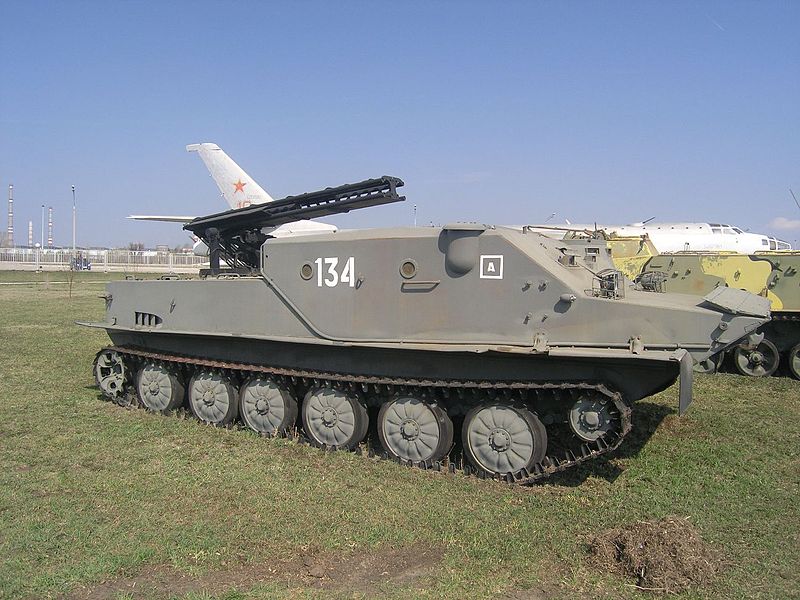 The UR-77 was not indeed the first of such mineclearing dedicated vehicle: The previous one was called the UR-67. This vehicle was based on the fully tracked APC BTR-50, derived from its BTR-50PK (Ob'yekt 750K) fitted with an armored roof in 1958. The UR-67 (ustanovka razminirovaniya) featured a rocket launcher system with three launchers, each towing a UZP-67, UZR-3 tube filled with explosives. This fabric container hose was folded down into the former troop compartment, in front of the engine. The cleared lane was 60 m up to 150 m long but only 2-5 m wide. A sub-variant was based on the amphibious PT-76 for a better tactical mobility in swampy areas, to cross rivers and at sea to perform beach mines clearing. NATO had them called MTK and MTK-1 respectively. A small number remained in service at the fall of the USSR, already replaced by the UR-77.
The UR-77 was not indeed the first of such mineclearing dedicated vehicle: The previous one was called the UR-67. This vehicle was based on the fully tracked APC BTR-50, derived from its BTR-50PK (Ob'yekt 750K) fitted with an armored roof in 1958. The UR-67 (ustanovka razminirovaniya) featured a rocket launcher system with three launchers, each towing a UZP-67, UZR-3 tube filled with explosives. This fabric container hose was folded down into the former troop compartment, in front of the engine. The cleared lane was 60 m up to 150 m long but only 2-5 m wide. A sub-variant was based on the amphibious PT-76 for a better tactical mobility in swampy areas, to cross rivers and at sea to perform beach mines clearing. NATO had them called MTK and MTK-1 respectively. A small number remained in service at the fall of the USSR, already replaced by the UR-77.
The UR-67 was already tested during the Arab-Israeli war of 1973 by the Syrians, and used across Africa and Vietnam as well by North Vietnamese forces. This experience was condensed into reports and gave birth to the UR-77 which solved all the shortcomings of the UR-67.
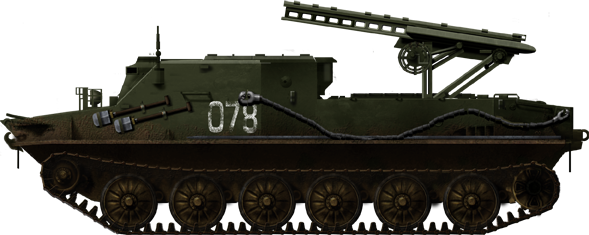
Author's illustration of the UR-67/BTR-50PK
Design of the UR-77
The UR-77 is a mine warfare vehicle developed in the early 1970s for the engineers corps, inspired by the British Giant Viper, and developed as the latter to clear paths through minefields quickly for troops to follow. Its main utility was to maintain the momentum a combined offensive, allowing the rapid crossing of a concentration of foot infantry or motorized units. There is conflcting information about the start of its development, 1977 is sometimes specified at the start of its development, and not the end (acceptance into service). There is no information on the bureau in charge of this development or director.The UR-77 was developed to gain time however on the 2S1 Gvozdika self-propelled howitzer, sharing the same elements with the older MT-LB multipurpose tracked vehicle. It has the same drivetrain, engine, welded armored hull, but the turret ring is now supporting a new kind of turret, with a hydraulically elevated launcher holding two missiles carriers, with a large space in which both explosive hoses are folded down.
Mobility
The crew is limited to just two, the Driver, doubling as mechanic and the Commander/operator of the vehicle, seating next to him during movements. Details of the armored hull are the same as the 2S1, with the same track-and-wheel arrangement and same powertrain, powerpack located in the front-right in the hull: A 300 hp V8 diesel engine, allowing a maximum road speed of 60 km/h. It is amphibiou, able to traverse calm water at 4 km/h. The running gear was composed of the same six small steel stamped, rubber-tired roadwheels, forward drive sprocket, rear track idler. Track link are not supported by track-return rollers, nor protected by armor skirts. The vehicle total weight was 34,200lb (far lighter than the 2S1 weighs at 35,300lb). It was suspended by torsion bars, with two hydraulic dampers. Its steel armor was only efficient against small arms fire and shell splinters. Although the UR-77 had not protection itself against mines not was fitted wth a dozer blade or mineroller to detonate possible leftover mines.Armament Operation
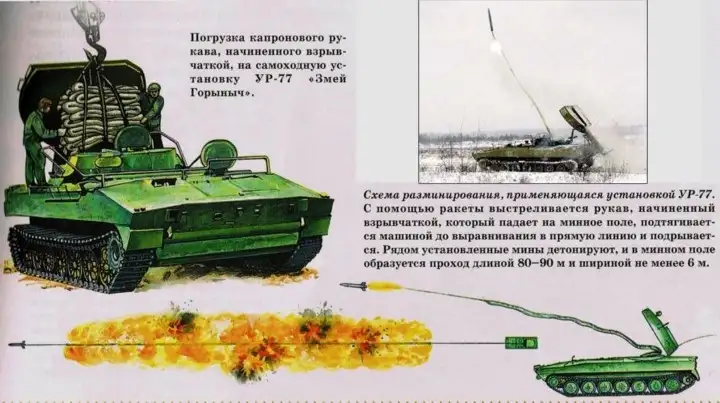
This consisting in just two demining charges: One single vehicle could thus clear two paths one after the other, each creating each a 90 x 6 meters "safe" area of the minefield. The UR-77 operated the UZ-67, UZP-77 and ZRShch types. The crew remains inside the vehicle during the operation. The demining charge itself is a nylon hose, filled with inert (electrically detonated) explosive equivalent to C4. An electric cable is connected top it. The explosive hose is launched over the minefield by a rocket, towing both the hose and eletric detonator cable. At the end of its flight path, the disconnect device is activated and disconnecting the missile. There is brake rope creating a charge upon landing, the vehicle retiring which pulls the brake rope, straightening the charge cable.
When done, the operator from the control panel setup via the wire an electric impulse for the detonation, initiating the explosion of the entire "snake". Mines are detonated in the defined area around, creating the passage. The full operating cycle is about 3-5 minutes, and for a deep minefield, the UR-77 could advance up to the end of the first path, and repeat the operation to clear up a path around 150 to 200m deep. However it need to retreat and reload for more, or cycle with another "fresh" vehicle. While safe at the rear, the full reloading sequence takes about 30-40 minutes. The explosion detonates mines in the immediate vicinity by overpressure (by sympathy), of all known types of mines, and dislodge others further away, making them easy to spot.
Specifications of the UR-77 | |
| Dimensions | 7.86, x 2.85 x 2.53m (travel configuration) |
| Total weight, battle ready | 15.5 tonnes |
| Crew | 2 (driver, commander/operator) |
| Propulsion | Yamz 238N diesel 300 hp, 5/1 speed Gbx, 19.3 hp/t |
| Suspension | Torsion bars |
| Speed (road) | 62 km/h (? mph) roads, 4-5 kph water. |
| Range | 550L fuel tank =500 km range |
| Armament | 2x mine rocket charges |
| Armor | Same as the MT-LB and 2S1: 20mm forward arc, 12-8mm elsewhere. |
| Total production | Unknown, circa 60 from 1977 |
Combat record of the UR-77
In Soviet service the UR-77 supplements the earlier UR-67. The UR-77 was designed to operate near the frontline, but is still not well armored enough to be part of a mechanized offensive. It can be covered while in operation by artillery and smoke, providing cover. In Syria it had been reportedly been used in urban terrain for bunker-busting or clearing out enemy positions. The same was repeat on the Donbass and in the current battles, like at Bakhmut. The UR-77 was exported in limited numbers but all remains in Russian service today. They are being replaced by a new generation of ground drones for full remote operations, the UR-07 (for 2007). The current UR-07 Peresortirovka is not well-known yet. It was stored in a training area near the village of Shimshinivka (27 km south-west of Luhansk) and used by Donbass separatists from 2014.First and Second Chechen Wars (2014-2023)
The First and Second Chechen Wars so Russian forces deplying the UR-77 on February 25, 1995 near Grozny, but stopped when heard about a "ftienfly fire" incident and the loss of 28 Russian special forces (Spetnaz). In the second Chechen war, they were used dedicedly for the first time in a urban combat "building cleaner" tp destroy Chechen fortified positions across the city. The UR-77 also played a key role in the battle for Komsomolskoye, shelling residential buildings. These tactics were reused in the Syrian civil war many years later, and up to this day, it has become its main role.War in Syria ()
The Syrian Civil War saw Russian Forces deploying the vehicle to clear up rebels positions and allw Syrian forces to take these, a tactic quite extensively featured in the Battle of Damascus and other urban battles.Current war in Ukraine (2014-2023)
The UR-77 was used in Donbass by Russian troops and separatists alike, playing an important role during the Donetsk airport assault. Later it was a common sight on training grounds and storage areas in territories not controlled by Ukraine along with the new UR-07. Some were also captured and reused by Ukrainian forces, to destroy trenches during its offensives. Since the start of the invasion in February 2022, it was used during the assault on Mariupol and Rubizhne and as of April 21, 2022, four of these has been identified as destroyed, nine captured by Ukrained, or abandoned. It is very clear that outside minefield, the vehicle, like in Syria, has been extensively used for shelling city blocks, and that tactic was prevalent during the battles for Rubizhne.Sources
Books/References
"Боевики ударили "Горынычем" по Марьинке: видео мощнейшего взрыва". Liga.net (in Russian). 9 July 2019.Tutov, Kuzma; Kuznetsov, Michael (17 December 2016). "Dangerous objects: the base of an army engineering unit of Russian invaders in Donetsk". Inform Napalm. Translated by Kalashnik, Evgeniy.
Beckhusen, Robert (12 October 2014). "Spotted — Al Assad's Brutal Mine-Clearing Tank in Syria". Medium.
Nekrasov, Mikhail (29 March 2017). "UR-77: Clearing one landmine at a time". Russia Beyond.
"UR 77 demining system used in urban warfare". Twitter.
Roblin, Sebastien (2022-04-26). "Russia's 'Meteorite' Could Be Putin's Secret Weapon to Kill Ukraine's Cities".
Links
On weaponsystems.netOn militaryfactory.com
On en.defence-ua.com
On medium.com/war-is-boring
On gagadget.com
walkaround on primeportal.net
On rbth.com
Use in Ukraine, armyrecognition.com
Videos
2
3
4
Model Kits
Conversion kit SP designs, for trumpeter, scalematesReview of the same
Gallery
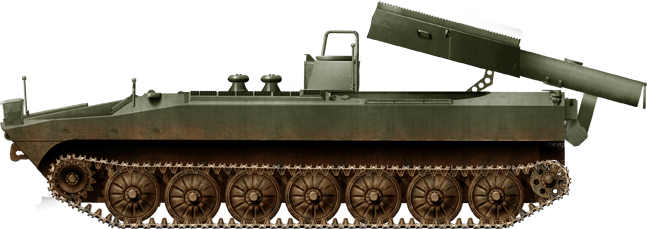
UR-77 in Soviet service, launcher up.

Same, launcher down.

Russian vehicle in tri-tone camouflage, 1990s

In winter camouflage in a competition, 2016

UR-77, Donbass 2017

UR-77 Sapper Exercise 2018
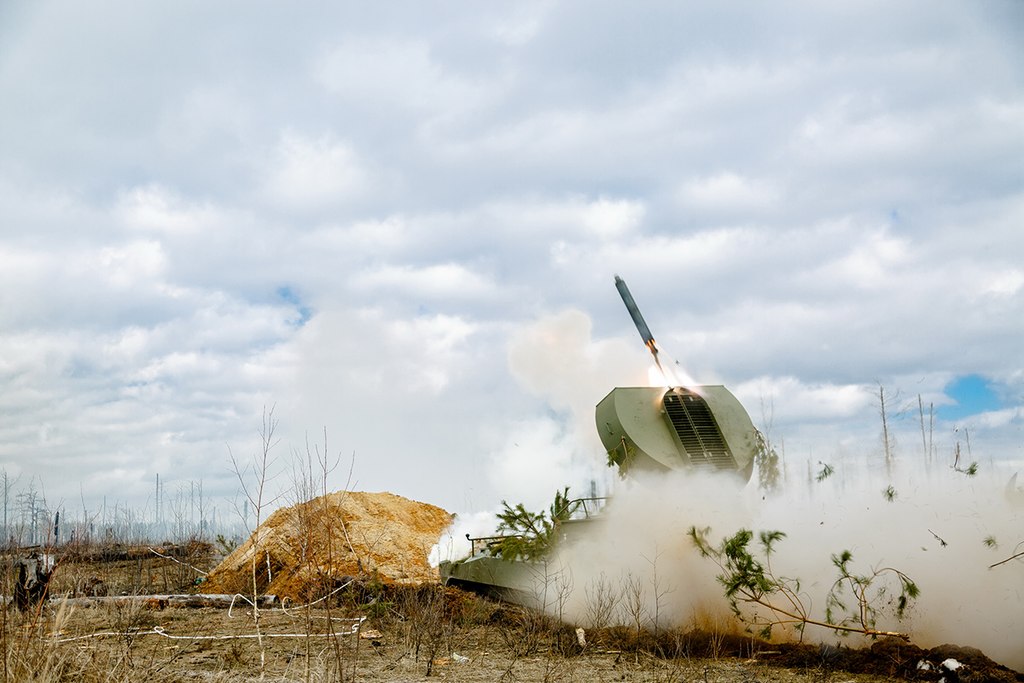
UR-77 in an Assault Exercise, 2017
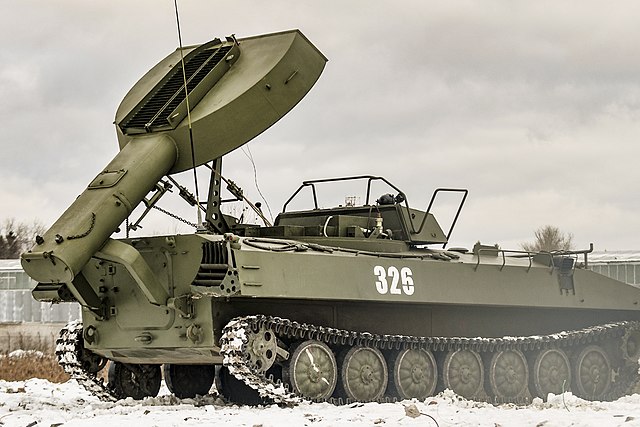
UR-77 launcher up at Engineer Exercise 2020
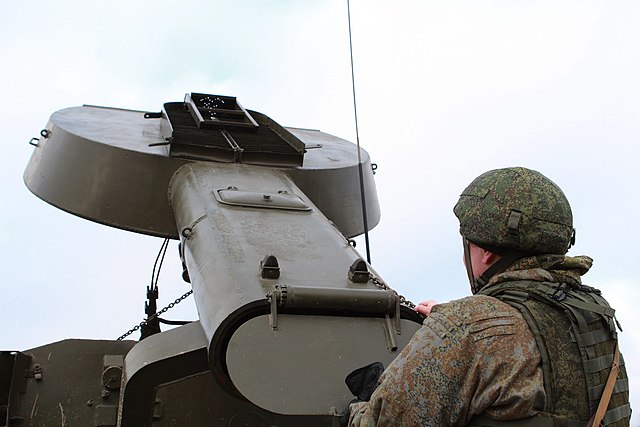
Reloading at Engineer Exercise 2018
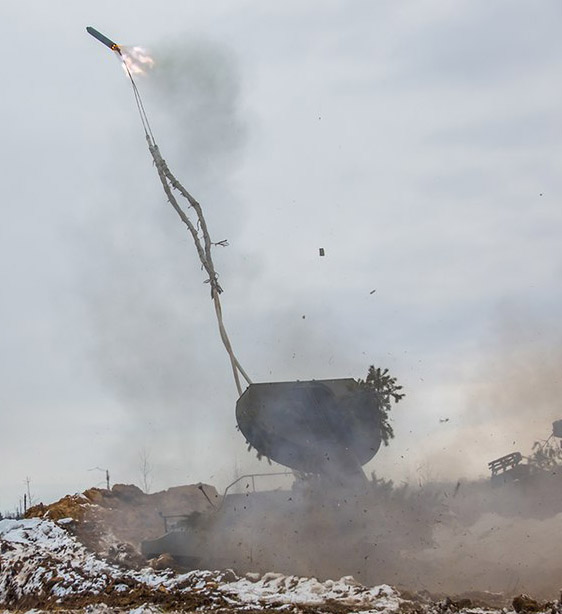
Firing start
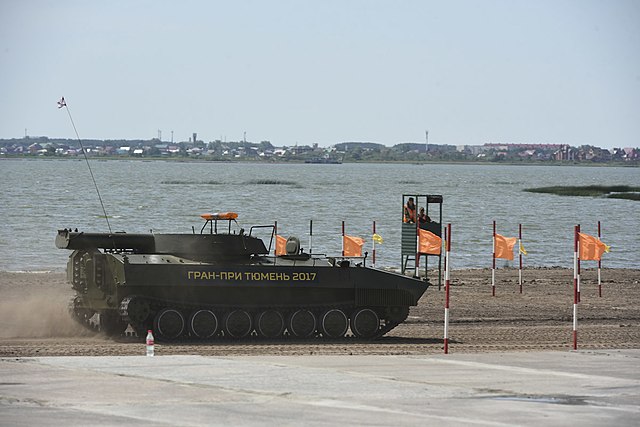
Engineering Formula 2017
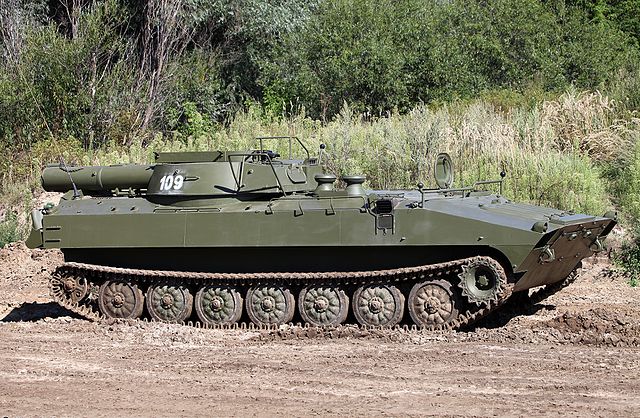
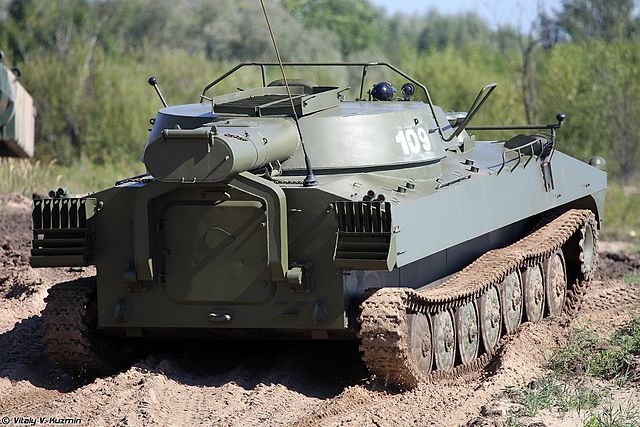
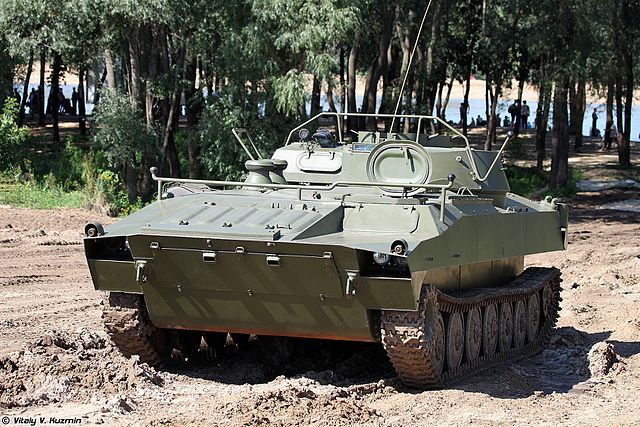
At Openwater 2016

Cold War Tanks


































Cold war tanks posters

Cold War Main Battle Tanks

Cold War Soviet Army

